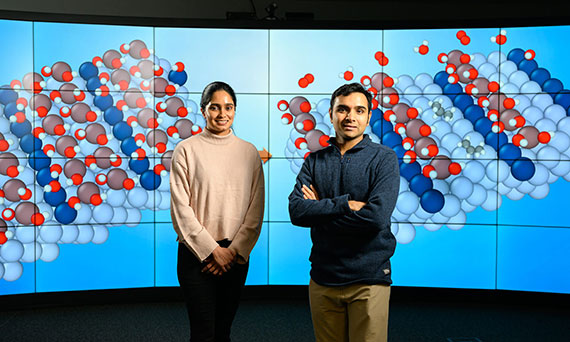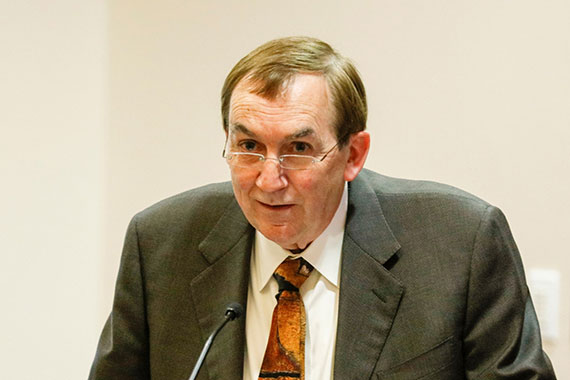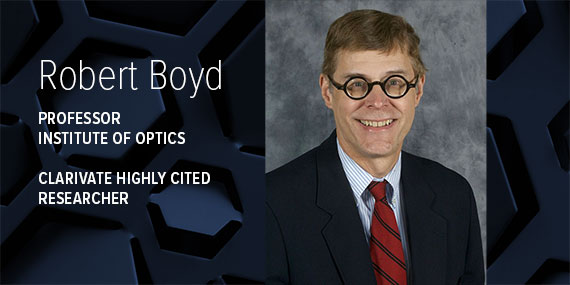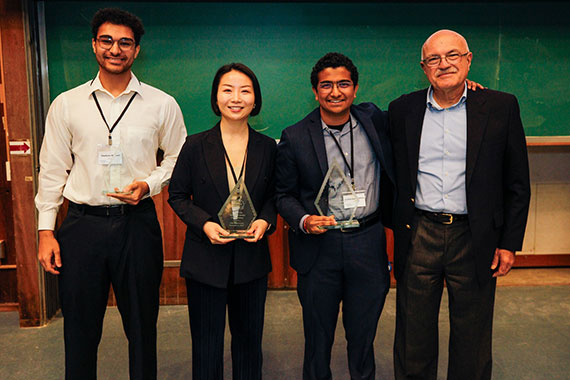November 17, 2025

University of Rochester photo / J. Adam Fenster
Dear members of the Hajim School community,
Researchers from the Department of Chemical and Sustainability Engineering developed algorithms that reveal key chemical steps that turn propane into propylene for countless everyday products from plastic spray bottles to outdoor furniture. In a study published in the Journal of the American Chemical Society, Assistant Professor Sid Deshpande and his PhD student Snehitha Srirangam provide atomic-level insight about what happens when tandem nanoscale catalysts cause these complex chemical reactions.
Sid says researchers can leverage their algorithmic approaches to understand the atomic structure of other chemical reactions such as methanol synthesis used for products ranging from paints to fuel cells. This detailed understanding of chemical reactions could ultimately help companies make chemical manufacturing more efficient.
Read about their findings at the News Center.
USING METASURFACES TO BOOST AR IMAGE CLARITY AND BRIGHTNESS

University of Rochester photo / J. Adam Fenster
Researchers from the Institute of Optics designed and demonstrated a new optical component that could significantly enhance the brightness and image quality of augmented reality (AR) glasses. The advance brings AR glasses a step closer to becoming as commonplace and useful as today’s smartphones.
In the journal Optical Materials Express, the team—led by Nickolas Vamivakas, the Marie C. Wilson and Joseph C. Wilson Professor of Optical Physics, and Jannick Rolland, the director of the Center for Freeform Optics and the Brian J. Thompson Professor of Optical Engineering—describes how they replaced the input port where the image enters the glass with one featuring three specialized zones, each made of a metasurface material, to achieve improved performance.
Read more about the advancement at the News Center.
DUNCAN MOORE NAMED OPTICA HONORARY MEMBER

Congratulations to Duncan Moore, the Rudolf and Hilda Kingslake Emeritus Professor of Optical Engineering at the Institute of Optics, on being named an Optica Honorary Member! This is the most distinguished of all Optica Member categories and is awarded by a unanimous vote of the Optica Board of Directors to individuals who have made seminal contributions to the field of optics. Their number is limited to two-thousandths of the Society’s total membership.
Duncan is an expert in gradient-index optics, computer-aided design and the manufacture of optical systems. He chaired the successful Hubble Independent Optical Review Panel organized in 1990 to determine the correct prescription of the Hubble Space Telescope. He also served as science advisor to Senator John D. Rockefeller IV of West Virginia for a one-year appointment and was confirmed by the US Senate in the fall of 1997 for the position of associate director for technology in the White House Office of Science and Technology Policy (OSTP). In this position, he worked with Dr. Neal Lane, President Clinton’s science advisor, to advise the President on US technology policy, including the Next Generation Internet, Clean Car Initiative, National Nanotechnology Initiative, ElderTech and CrimeTech.
Duncan is recognized by Optica “for pioneering contributions to gradient-index optics, leadership in public policy, dedicated service to the optics community and distinguished roles in academia, government and professional societies.”
Read more about his accomplishments at the Optica website.
BOB BOYD NAMED TO CLARIVATE’S LIST OF ‘HIGHLY CITED RESEARCHERS’

For the third year in a row, Professor Bob Boyd, Dean’s Professor in the Institute of Optics earned a spot on Clarivate’s list of Highly Cited Researchers. Bob is known for his pioneering work in nonlinear optical interactions and nonlinear optical properties of materials.
The Highly Cited Researchers 2025 list identifies and celebrates individuals who have demonstrated significant and broad influence in their fields of research. Each researcher selected has authored multiple Highly Cited Papers which rank in the top 1% by citations for their field(s) and publication year in the Web of Science Core Collection over the past eleven years.
See the full 2025 list on the Clarivate website.
HAJIM STUDENTS SWEEP THE MARK AIN BUSINESS COMPETITION

I’m pleased to share that Hajim students had fantastic results at the annual Mark Ain Business Model Competition. Established in 2007, the competition provides aspiring student entrepreneurs at the University of Rochester an opportunity to present their business idea (in any industry) and compete for $13,500 in cash prizes. Students who wish to enter the competition must be enrolled in the Ain Foundry Program. Here are this year’s winners:
- First place was awarded to Scyntek, represented by mechanical engineering PhD student Karthik Ramakrishnan, for their device to monitor blood clots.
- Second place was awarded to Vivoflux, represented by biomedical engineering PhD candidate Kaihua (Chloe) Chen, for the Flow Insert platform, which transforms any static culture on glass slides, well plates, or microphysiological systems (MPS) into a dynamic, perfused model that mimics real tissue environments.
- Third place was awarded to Convort, represented by Hashem Alomari ’27 (computer science), for its recruiting app, AI-powered career fair intelligence, and performance platform. Convort allows users to quickly discover their best-fit companies at career fairs, engage recruiters confidently with AI-powered talking points, and convert handshakes into interviews.
ROCKETRY CLUB ACHIEVES LIFTOFF

Congratulations to one of our newest student organizations, the University of Rochester Rocketry Club, which hit a major milestone by hosting their first launch! The team documented the occasion on their Instagram account. Onward and upward!
GIDS-AI AWARDS SEED FUNDING TO 7 NEW PROJECTS
The Goergen Institute for Data Science and Artificial Intelligence (GIDS-AI) announced seed funding awards for seven collaborative projects for the 2025-2026 year. The GIDS-AI seed funding program aims to support collaborative research efforts toward attracting major external funding, with a particular focus on work aligned with the Institute’s research priorities in data science and artificial intelligence.
The projects showcase an exciting array of interdisciplinary work. This year’s project titles and awardees are:
- Training generative artificial intelligence to identify disease associated cell states
- Standardizing Obstetric Ultrasound Segmentation Using Hardware-agnostic Unsupervised Multi-Sweep Diffusion Generative Adversarial Network for Enhanced Generalization
- Participatory Fair Division
- Fetal Weight Estimation Using Ultrasound Video from Low-Risk Pregnancies: A Prospective Study
- All-Optical Diffusion-based Image Generation
- Enabling Large Camera Motion Control in Video Diffusion Models via External 3D Geometry
- Large Context LLM Inference Using Hierarchical Recency
Go to the GIDS-AI website to learn more about the projects.
THE INSTITUTE OF OPTICS TO HOST FAMILY NIGHT ON DECEMBER 13
The Institute of Optics will host its annual family night event from 4-7 p.m. on Saturday, December 13 in Goergen Hall. This is a fun event for all ages, where attendees get to see and interact with the science of light. Activities include balloon popping with lasers, polarization, CO2 laser engraving, thermal imaging, holography, the Optics Suitcase, and more. Parking is free but please register ahead of time to ensure there are enough cookies!
NSF I-CORPS HYBRID COURSE—SPIE OPTICS AND PHOTONICS

In a monthlong hybrid course from December 22 to January 28, a select group of researchers working on optics or photonics technologies will get out of their comfort zone and talk to customers at the SPIE Photonics West conference to identify the best product-market fit. Hosted in partnership with the University of Rochester and Dartmouth College, the course begins online and culminates with a trip to San Francisco for SPIE Photonics West. Up to $5,000 (depending on team size) in travel reimbursement funding will be available for accepted teams. Teams of 1-3 people are encouraged to apply via this form.
Have a great week!
Your dean
Wendi Heinzelman